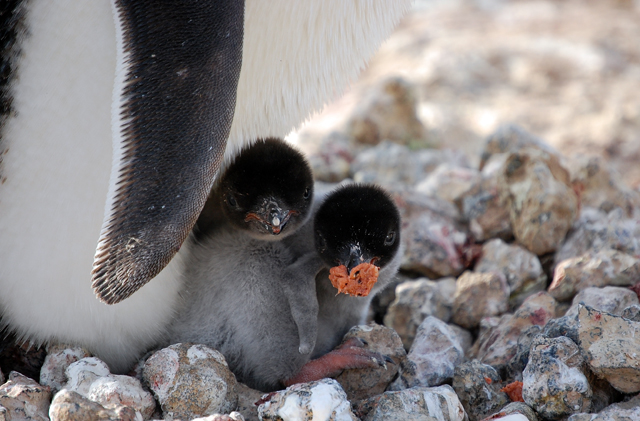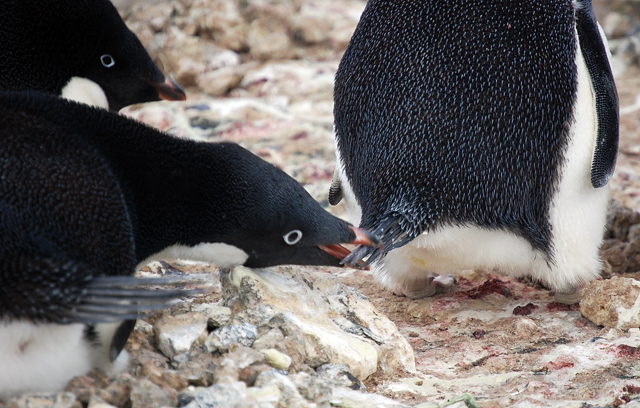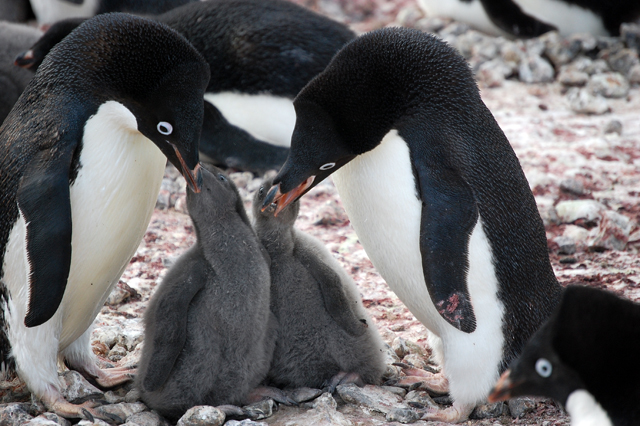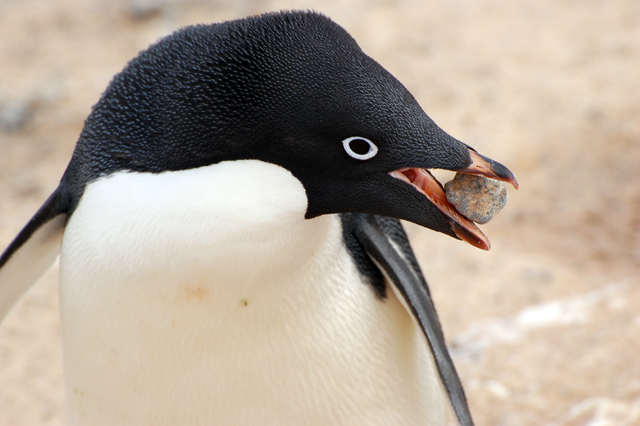The penguin perspective
These 'cuddly' birds live on the edge — and have something to teach us about life
Posted January 28, 2011
Penguins truly are one of the feel-good animals.
But there is very little fun loving or playful about the lives of Adélies. They live in the most brutal environment in the world — on the brink of catastrophe at all times. They survive by running the behavior code embedded in their genes, which were laid down by countless successful generations before them.
There is no wasted motion; energy is too expensive here. Living and reproducing takes it all. During the cycle of the seasons, these birds may experience temperatures as low as minus 30 degrees Celsius, and it rarely gets above freezing, even in the summer. Add wind that can blow steady for days at 65 to 80 kilometers per hour, and you have the challenge of the Southern Ocean.
Daily life means standing barefooted on the ice, hoping your coat of feathers is enough to defend your body heat against the wind. Eating means swimming through subfreezing water chasing krill or small fish while avoiding the sharp eye and voracious appetite of leopard seals.
But nature was not stingy with adaptations for penguin survival.
Its physiology allows rapid fat deposition, for maximum feathers per square surface area, and a body form unparalleled in hydrodynamic design. In one year, they can gain and lose 30 percent of their body mass — twice.
As I sit in the breeding colony at Cape Royds on Ross Island near McMurdo Station
And that’s before I would have to look for my own food. We are the fragile species. They must stare at us and wonder, “What are those people doing here?”
Watching penguins is habit forming, but luckily neither fattening nor a health risk. After four seasons and 1,500 hours observing these birds overcome the obstacles of survival, I still get the feeling I am watching them for the first time. Every day a new drama unfolds, and I see pieces of us in their behavior and lessons to learn. The gift of returning to the same colony every year allows me to get to know breeding pairs well. More than a snapshot, I have collected a family album of their lives.
Unlike other birds and most animals, but similar to humans, their faces are perpendicular to their bodies and their legs in line with their backbones. These attributes add to their humanness and their engaging appeal. Giving human traits and feelings to these charismatic creatures is called anthropomorphizing. Not scientific, but it is hard to resist.
Just like us, they squabble with their neighbors and mate. Nests on the inside of a breeding neighborhood are safer than ones on the edge. Inside adults coming and going from the center must walk through the property of its neighbors. Pecks and jabs abound, and the intruder runs quickly to avoid as much punishment as possible.
The neighbor’s nest rocks are so much easier to get than the ones way over there, so why not steal one when its owner isn’t looking? While Murray is stealing from Joe on one side, I have seen Larry steal from Murray on the other side. The roulette cycle of rocks throughout the group never stops. It reminds me of borrowing tools in the neighborhood where I grew up. At some point, we did not know which wrench really belonged to whom.
Penguins divorce and remarry. The Antarctic breeding season is short. A male will build a nest and wait for last year’s mate to return. But not long, for time is valuable and so new courtships occur. Returning females unable to locate their former beau will similarly seek another male. Mates returning late may find their place taken. Fights do occur, but most disputes end peacefully, with very little blood shed
Penguins take life and death in stride
When a mate returns to the nest a barrage of vocalization greets her. Scientific papers say it is for mate recognition. However, I know what it’s like to be hungry, grumpy and left home alone taking care of the chicks all day.Perhaps the communication goes along the lines of “Where have you been” or “You have been gone too long,” “Did you bring home enough food for everyone?” When the returning mate finally settles onto the nest, releasing the tired, hungry adult, the exchange continues with more chorus. “You are standing on the chicks,” “You are too far over there,” “Move your foot here.”
I like to believe their exchange is more than merely recognition, as these birds interact with their mates through the exhaustive work of raising chicks.
Penguins also yell at the kids. When my children were babies they could do no wrong, but by the time they were toddlers, rules and restrictions began to apply: crossing the street was not allowed. A newly hatched Adélie chick is helpless and spends much of its time under the body of the adult. By the time they are two weeks old, the world outside the nest looks exciting, and forays to the edge of the rock circle has appeal.
But predatorial skuas and cold are ever present, and these chicks can’t defend themselves from either. Adults communicate loudly to their chicks and work them back into safety. As the chicks become older and bolder, adults must continue to beckon them back.
Penguins clean up around the house. A pile of rocks is a castle to an Adélie, and maintenance is never ending. Tidying up around the nest is a constant battle, as rocks roll out, fall out, are kicked out, or stolen and need to be replaced. Before leaving on a foraging trip, a male will bring rocks one at a time to the nest, as if bringing a precious stone to its mate. He gently lays it near the nest for her to arrange as she wishes. Perhaps to promise, “I will return,” as he goes off to find food.
There is one penguin family per nest, with nests arranged in neighborhoods. Nesting territory is respected, and violators are punished. But once away from home, penguins are gregarious and group oriented. Personal space becomes non-existent, and group dynamics are always entertaining.
Food is in the ocean, but so is danger in the form of leopard seals. At the sea ice edge, no one wants to go in alone or be the first. Large numbers gather near the edge, and there is always a great deal of chattering and jostling as the group determines the time of entry. Hours of watching have not revealed what causes the group to dive in. But when they do, it is en mass. Does one push another, does one fall, or does one take the brave and daring lead, causing the others to follow blindly?
Following a self-proclaimed leader, assuming his decision was in your best interest, has always been part of a group dynamic. Here, as everywhere, there is a bunch of noise.
One astoundingly quiet event in the life of penguins is loss. Adélies fiercely defend their nest and offspring, but eggs roll out or get broken, and skuas covertly steal eggs and chicks. When catastrophe occurs, and the nest is empty, there is neither nary a peep nor a cry.
Feathers are fluffed, then smoothed, and the adults get on with the business of living. Sometimes they linger at the nest site for a day or two, but do not seem to mourn the efforts of a season lost. However, not deterred from the genetic program they run, they will return next year to do it all over again.
Who is like whom? It’s the penguin-human dilemma. Penguins have been around longer than we have. If there had been a witness a million years ago, would she have seen their behavior as a preview of what humans would become rather than a mirror of what we are now?
If our societies were scrutinized side by side, how would humans favor? These birds are masters in their environment, yet do no damage, supreme in their ability to survive. They harm no one, fiercely defend their families, yet take loss in stride and move on.
I still get the feeling I am watching them for the first time. And always learning.
Jean Pennycook works to bring the world of Antarctica, scientific research and penguins to classrooms around the world through her education outreach activities. She is currently an Einstein Fellow at the National Science Foundation. She works with a team led by David Ainley, an ecologist with H.T. Harvey & Associates. Learn more about their research at www.penguinscience.com.
Source
























No comments:
Post a Comment